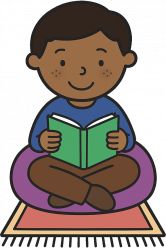10 Fun Ways to Boost Reading Skills for Struggling KS1 Readers
Understanding the Challenges Struggling Readers Face
Key Stage One (KS1) is a crucial stage in a child's literacy development, but many children face challenges when learning to read. These challenges can vary widely, from difficulties in recognising letters and sounds to struggling with comprehension and fluency. Identifying these issues early is essential to providing effective support and intervention. 
Children's reading difficulties often stem from a variety of underlying issues, such as dyslexia, language barriers, or lack of exposure to books at home. Recognising that each child is unique and may require different strategies to overcome their challenges is vital. Tailoring approaches to meet individual needs ensures that every child has the opportunity to succeed.
Early identification and intervention can significantly impact a child's reading journey. By assessing and understanding each child's specific difficulties, teachers and parents can implement targeted strategies to address these issues effectively. This proactive approach can prevent minor difficulties from becoming significant obstacles to literacy development.
Incorporating Sensory Experiences into Reading
Incorporating sensory experiences into reading activities can make learning more engaging and enjoyable for young children. Sensory reading experiences involve using the senses - sight, touch, sound, and even smell - to enhance the reading process. These activities can help children connect with the material in a more meaningful way.
Different types of sensory activities can be incorporated into reading sessions. For example, using textured books, where children can feel different surfaces, or listening to audiobooks that provide a rich auditory experience. These sensory elements can make the process of learning to read more dynamic and interesting for struggling readers.

Sensory experiences not only make reading more enjoyable but also aid in retention and comprehension. Children are more likely to remember what they have read when multiple senses are engaged. This multi-sensory approach can be particularly beneficial for children with learning difficulties, helping them to better grasp and retain new information.
Using Interactive and Tactile Resources
Interactive and tactile resources can play a significant role in supporting young readers. These tools make reading a hands-on experience, which can be particularly beneficial for children who struggle with traditional methods. Mighty Writer, for example, is a resource that combines visual, tactile, and interactive elements to aid literacy learning.
The benefits of using resources like Mighty Writer are numerous. This tool can transform reading from a passive activity into an interactive and engaging experience. By involving children in the process of constructing sentences and stories, these resources can enhance their understanding of language and sentence structure.

In a classroom setting, interactive and tactile resources can be used in various ways. Teachers can use them during guided reading sessions or as part of a literacy centre. These resources can also be used for individual or group activities, making them versatile tools for enhancing literacy instruction and engagement.
Creating a Positive Reading Environment
Creating a positive and encouraging reading environment is essential for helping struggling readers build confidence and improve their skills. A welcoming and supportive atmosphere can make a significant difference in how children perceive reading and their willingness to engage with it.

Setting up a conducive reading space at home or school involves creating a comfortable and inviting area where children feel safe and motivated to read. This can include having a variety of books available, comfortable seating, and a quiet, distraction-free zone dedicated to reading activities.
A positive reading environment also includes positive reinforcement and encouragement from teachers and parents. Celebrating small achievements and providing constructive feedback can boost a child's confidence and foster a love for reading. When children feel supported and valued, they are more likely to persevere and succeed in their reading efforts.
Tailoring Reading Materials to Children's Interests
Personalising reading materials to match a child's interests can significantly increase their motivation to read. Children are more likely to engage with and enjoy reading when the content is relevant and interesting to them. This personalised approach can make a substantial difference for struggling readers.
Finding and selecting suitable reading materials involves understanding the child's hobbies, passions, and curiosities. For instance, if a child loves animals, choosing books about wildlife or animal adventures can capture their interest and encourage them to read more. This tailored approach helps to create a more enjoyable and meaningful reading experience.

Using interest-based reading materials not only boosts motivation but also improves comprehension and retention. When children are interested in what they are reading, they are more likely to pay attention and absorb the information. This strategy can help struggling readers develop a deeper connection to the content and foster a love for reading.
Making Reading Enjoyable with Games and Activities
Incorporating games and playful activities into reading sessions can make the process more enjoyable and less daunting for struggling readers. Learning through play is an effective way to engage children and make reading fun. This approach can help to alleviate the pressure and frustration that often accompany reading difficulties.
Various games and activities can support reading development. For example, word matching games, scavenger hunts for letters or words, and interactive story-telling sessions can make reading more dynamic and engaging. These activities can be adapted to suit different reading levels and interests, ensuring that all children can participate and benefit.

The effectiveness of learning through play is well-documented. Playful activities encourage active participation, collaboration, and critical thinking. For struggling readers, these activities provide a low-pressure environment where they can practice and improve their reading skills while having fun.
Using Visual Aids and Colourful Images for Comprehension
Visual aids and colourful images can significantly enhance reading comprehension for young children. These tools provide additional context and support, helping children to understand and remember what they read. For struggling readers, visual aids can be particularly beneficial in making sense of complex text.

Various types of visual aids can be used to support reading. Picture books, charts, diagrams, and illustrated storybooks all provide visual elements that can aid comprehension. These aids can help children to visualise the story, understand the sequence of events, and grasp the meaning of unfamiliar words.
Using visual aids and colourful images can make reading more accessible and enjoyable for struggling readers. These tools can break down barriers to understanding and provide alternative ways to engage with the text. By incorporating visual elements, teachers and parents can create a more inclusive and supportive reading environment.
Breaking Down Reading Tasks into Manageable Pieces
Breaking down reading tasks into manageable, bite-sized pieces can make the process less overwhelming for struggling readers. Small, achievable goals can help children to focus and build their confidence gradually. This approach ensures that reading activities are accessible and not too daunting.
Effectively segmenting reading activities involves planning and structuring tasks to suit the child's pace and ability. For example, reading a few pages at a time or focusing on one paragraph before moving on can make the task more manageable. This method helps to maintain the child's interest and prevent frustration.
Breaking down reading tasks can have several benefits. It allows children to experience success more frequently, which can boost their confidence and motivation. This approach also helps to develop a sense of achievement and progress, encouraging children to continue improving their reading skills.
Implementing Regular, Short Reading Sessions
Short, regular reading sessions can be more effective than long, infrequent ones, especially for struggling readers. Consistency and routine are key to developing reading skills and building confidence. Regular practice helps children to reinforce what they have learned and make steady progress.

Implementing short reading sessions involves setting aside dedicated time for reading each day. These sessions can be as brief as 10-15 minutes, focusing on quality rather than quantity. This approach ensures that children remain engaged and do not become overwhelmed or fatigued.
Consistency in reading practice is crucial for building fluency and comprehension. Regular, short sessions provide ongoing opportunities for children to practice and improve their skills. This routine helps to establish reading as a habit and an integral part of their daily lives.
Encouraging and Celebrating Achievements
Encouragement and celebration of small achievements are vital in building a child's confidence and motivation to read. Recognising and celebrating progress, no matter how small, can have a profound impact on a struggling reader's self-esteem and willingness to continue learning.
There are many ways to celebrate and encourage children. Simple gestures such as praise, stickers, or a small reward can make a big difference. Creating a chart to track progress and celebrate milestones can also provide visual evidence of their achievements and motivate them to keep going.
Positive reinforcement is a powerful tool in building confidence and fostering a love for reading. By celebrating successes and providing encouragement, educators and parents can help children to see reading as a rewarding and enjoyable activity. This supportive approach can inspire struggling readers to persevere and ultimately succeed in their literacy journey.
